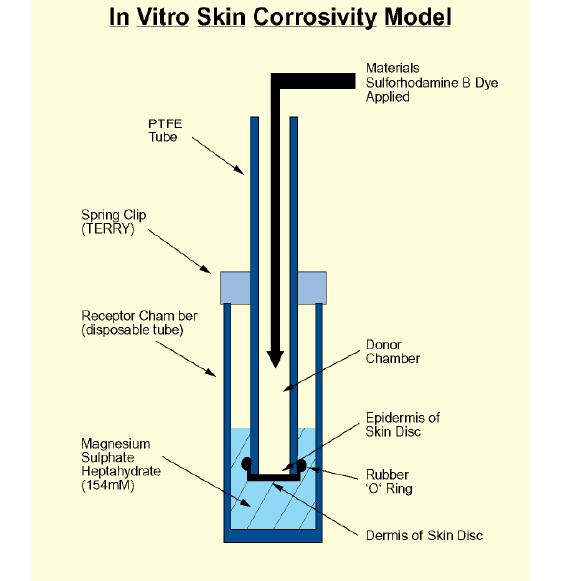Skin corrosion refers to the production of irreversible damage to the skin manifested as visible necrosis through the epidermis and into the dermis, following the application of a test material.
Animals are humanely killed when 28−30 days old; this age is critical. The dorso-lateral skin of each animal is then removed and stripped of excess subcutaneous fat by carefully peeling it away from the skin. Skin discs, with a diameter of approximately 20 mm each, are removed.
Concurrent positive and negative controls should be used for each study to ensure adequate performance of the experimental model. Skin discs from a single animal should be used. The suggested positive and negative control substances are 10M hydrochloric acid and distilled water, respectively. Liquid test substances (150 μL) are applied uniformly to the epidermal surface inside the tube. When testing solid materials, a sufficient amount of the solid is applied evenly to the disc to ensure that the whole surface of the epidermis is covered. Deionised water (150 μL) is added on top of the solid and the 168 tube is gently agitated. In order to achieve maximum contact with the skin, solids may need to be warmed to 300 °C to melt or soften the test substance, or ground to produce a granular material or powder. Three skin discs are used for each test and control substance. Test substances are applied for 24 hours at 20-230 °C. The test substance is removed by washing with a jet of tap water at up to 300 °C until no further material can be removed.
The test material is applied for up to 24 hours to the epidermal surfaces of skin discs in a two-compartment test system in which the skin discs function as the separation between the compartments. The skin discs are taken from humanely killed rats aged 28−30 days. Corrosive materials are identified by their ability to produce a loss of normal stratum corneum integrity and barrier function, which is measured as a reduction in the TER below a threshold level.
The skin impedance is measured as TER by using a low-voltage, alternating current Wheatstone bridge.
The test substance is considered to be non-corrosive to skin:
i) if the mean TER value obtained for the test substance is greater than 5 kΩ, or
ii) the mean TER value is less than or equal to 5 kΩ, and the skin disc is showing no obvious damage, and the mean disc dye content is well below the mean disc dye content of the 10M HCl positive control obtained concurrently).
The test substance is considered to be corrosive to skin:
i) if the mean TER value is less than or equal to 5 kΩ and the skin disk is obviously damaged
ii) the mean TER value is less than or equal to 5 kΩ, and the skin disc is showing no obvious damage, but the mean disc dye content is greater than or equal to the mean disc dye content of the 10M HCl positive control obtained concurrently.
